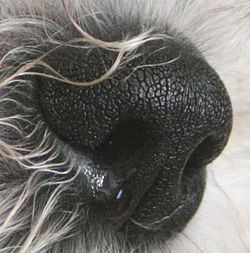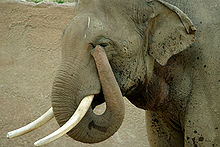- Nose
-
For other uses, see Nose (disambiguation).For the article about noses in humans, see human nose.
Nose 
Dogs have very sensitive noses Latin 'Nasus' Anatomically, a nose is a protuberance in vertebrates that houses the nostrils, or nares, which admit and expel air for respiration in conjunction with the mouth. Behind the nose are the olfactory mucosa and the sinuses. Behind the nasal cavity, air next passes through the pharynx, shared with the digestive system, and then into the rest of the respiratory system. In humans, the nose is located centrally on the face; on most other mammals, it is on the upper tip of the snout.
Contents
Air conditioning
As an interface between the body and the external world, the nose and associated structures frequently perform additional functions concerned with conditioning entering air (for instance, by warming and/or humidifying it, also for flicking if moving and by mostly reclaiming moisture from the air before it is exhaled (as occurs most efficiently in camels). The nose often has inner hairs whose function is to stop unwanted particles from entering the lungs.
Sense of direction
The wet nose of dogs is useful for the perception of direction. The sensitive cold receptors in the skin detect the place where the nose is cooled the most and this is the direction a particular smell that the animal just picked up comes from.[1]
Structure in air-breathing forms
In amphibians and lungfish, the nostrils open into small sacs that, in turn, open into the forward roof of the mouth through the choanae. These sacs contain a small amount of olfactory epithelium, which, in the case of caecilians, also lines a number of neighbouring tentacles. Despite the general similarity in structure to those of amphibians, the nostrils of lungfish are not used in respiration, since these animals breathe through their mouths. Amphibians also have a vomeronasal organ, lined by olfactory epithelium, but, unlike those of amniotes, this is generally a simple sac that, except in salamanders, has little connection with the rest of the nasal system.[2]
In reptiles, the nasal chamber is generally larger, with the choanae being located much further back in the roof of the mouth. In crocodilians, the chamber is exceptionally long, helping the animal to breathe while partially submerged. The reptilian nasal chamber is divided into three parts: an anterior vestibule, the main olfactory chamber, and a posterior nasopharynx. The olfactory chamber is lined by olfactory epithelium on its upper surface and possesses a number of turbinates to increase the sensory area. The vomeronasal organ is well-developed in lizards and snakes, in which it no longer connects with the nasal cavity, opening directly into the roof of the mouth. It is smaller in turtles, in which it retains its original nasal connection, and is absent in adult crocodilians.[2]
Birds have a similar nose to reptiles, with the nostrils being located at the upper rear part of the beak. Since they generally have a poor sense of smell, the olfactory chamber is small, although it does contain three turbinates, which sometimes have a complex structure similar to that of mammals. In many birds, including doves and fowls, the nostrils are covered by a horny protective shield. The vomeronasal organ of birds is either under-developed or altogether absent, depending on the species.[2]
 Elephants have prehensile noses.
Elephants have prehensile noses.
The nasal cavities are exceptionally large in most mammals, typically occupying up to half the length of the skull. In some groups, however, including primates, bats, and cetaceans, the nose has been secondarily reduced, and these animals consequently have a relatively poor sense of smell. The nasal cavity of mammals has been enlarged, in part, by the development of a palate cutting off the entire upper surface of the original oral cavity, which consequently becomes part of the nose, leaving the palate as the new roof of the mouth. The enlarged nasal cavity contains complex turbinates forming coiled scroll-like shapes that help to warm the air before it reaches the lungs. The cavity also extends into neighbouring skull bones, forming additional air cavities known as paranasal sinuses.[2]
In cetaceans, the nose has been reduced to the nostrils, which have migrated to the top of the head, producing a more streamlined body shape and the ability to breathe while mostly submerged. Conversely, the elephant's nose has elaborated into a long, muscular, manipulative organ called the trunk.
The vomeronasal organ of mammals is generally similar to that of reptiles. In most species, it is located in the floor of the nasal cavity, and opens into the mouth via two nasopalatine ducts running through the palate, but it opens directly into the nose in many rodents. It is, however, lost in bats, and in many primates, including humans.[2]
In fish
Fish generally have a weak sense of smell, which is generally less important than taste in an aquatic environment. They do, however, possess a nose, although, unlike that of tetrapods, it has no connection with the mouth, nor any role in respiration. Instead, it generally consists of a pair of small pouches located behind the nostrils at the front or sides of the head. In many cases, each of the nostrils is divided into two by a fold of skin, allowing water to flow into the nose through one side and out through the other.[2]
The pouches are lined by olfactory epithelium, and commonly include a series of internal folds to increase the surface area. In some teleosts, the pouches branch off into additional sinus-like cavities, while in coelacanths, they form a series of tubes. Unlike tetrapods, the nasal epithelium of fishes does not include any mucus-secreting cells, since it is already naturally moist.[2]
In the most primitive living vertebrates, the lampreys and hagfish, there is only one nostril and olfactory pouch. Indeed, the nostril also opens into the hypophysis. This is not necessarily, however, a primitive trait, but one that may have arisen later in the evolution of these particular groups. For example, the fossil heterostracans had paired nostrils, and these were also a very early vertebrate group.[2]
See also
- Human nose
- Nasal bridge
- Rhinarium, the wet, naked surface around the nostrils in most mammals, absent in haplorrhine primates such as humans
References
External links
 Media related to nose at Wikimedia Commons
Media related to nose at Wikimedia Commons
Human systems and organs TA 2–4:
MSBone (Carpus · Collar bone (clavicle) · Thigh bone (femur) · Fibula · Humerus · Mandible · Metacarpus · Metatarsus · Ossicles · Patella · Phalanges · Radius · Skull (cranium) · Tarsus · Tibia · Ulna · Rib · Vertebra · Pelvis · Sternum) · CartilageTA 5–11:
splanchnic/
viscusmostly
Thoracicmostly
AbdominopelvicDigestive system+
adnexaMouth (Salivary gland, Tongue) · upper GI (Oropharynx, Laryngopharynx, Esophagus, Stomach) · lower GI (Small intestine, Appendix, Colon, Rectum, Anus) · accessory (Liver, Biliary tract, Pancreas)TA 12–16 Blood
(Non-TA)General anatomy: systems and organs, regional anatomy, planes and lines, superficial axial anatomy, superficial anatomy of limbsCategories:
Wikimedia Foundation. 2010.

